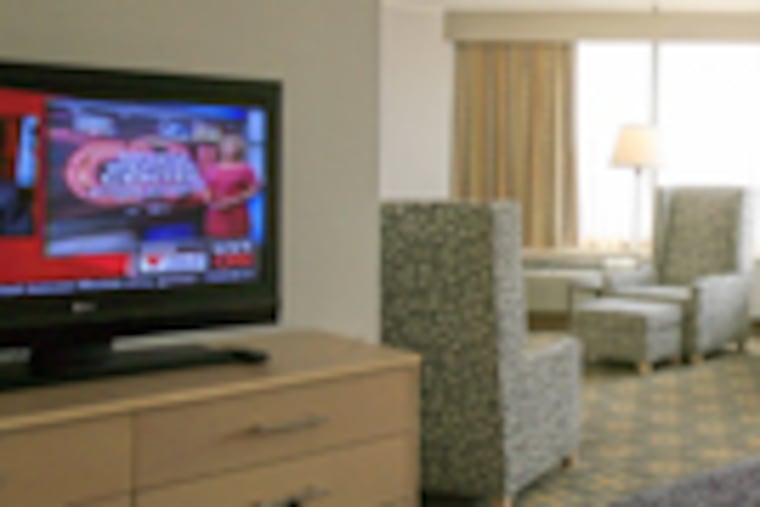Doubletree winds up another renovation phase
In these difficult times when hoteliers nationally are struggling to put heads in beds, why would a Center City hotel invest millions of dollars in a new look?

In these difficult times when hoteliers nationally are struggling to put heads in beds, why would a Center City hotel invest millions of dollars in a new look?
"We made the gutsy move in preparation for when the economy improves," said Doubletree Hotel Philadelphia general manager Bill Fitzgerald.
While the timing of the recovery remains unknown, choosing to refresh is a necessary tactic in the hotel industry - even in a downturn, experts say.
The Doubletree, at Broad and Locust Streets, began a $13.2 million renovation in December 2006 during flush economic times, and decided to plow ahead to complete it even as the recession took hold and occupancy slid.
Tomorrow, the hotel will unveil 432 rooms fully refurbished at a cost of $11.5 million, and mark the completion of Phase 2 of a three-phase renovation.
The hotel had spent $1.3 million in 2007 to gut old guest rooms into 4,700-square feet of meeting space, known as Assembly on Five (the hotel's fifth floor).
Next in line are the hotel's public spaces, including the lobby and pool, which will be redone starting in late fall for $350,000.
The Doubletree's major overhaul comes at a time when occupancy and room rates have plummeted at hotels across the country.
Based on Smith Travel Research data, total U.S. revenue per available room, or (RevPAR) - a key revenue metric in the hotel industry - was down 22.9 percent for the first week of this month, versus a year ago. Occupancy was down 13.9 percent, and average daily rate decreased 10.5 percent.
"A majority, from two-thirds to three-quarters, of the declines in RevPAR can be attributed to lower average room rates as travelers of all types shop for bargains knowing that hotel demand is soft," said Peter Tyson of PKF Consulting in Center City.
At the Doubletree, a brand owned by Hilton Hotels Corp., Fitzgerald estimated 68 percent occupancy for the year, partly due to rooms out of inventory for renovations and the economy. That figure is slightly above the 65.7 percent projected for Center City hotels by PKF Consulting, but down considerably from 80 percent occupancy in both 2006 and 2007, and last year's 77 percent occupancy.
Hospitality experts say 70 percent occupancy is considered healthy for a hotel.
Fitzgerald said the average daily rate at the Doubletree will be down 8 percent from a year ago, compared with a projected 10 percent decrease citywide.
The Doubletree, which competes mostly with the Marriott, Sheraton, and Crowne Plaza brands as an upscale hotel, relies on 45 percent of its business from group travel (that includes citywide conventions and corporate and social groups), 30 percent from individual business travel, and 25 percent from weekend leisure travel.
Fitzgerald said all three sectors were down this year: Business travel was down 9-10 percent; group travel was down 8-10 percent, partly due to fewer attendees at citywide conventions at the Pennsylvania Convention Center, and leisure travel was down about 3 percent.
Consultant Tyson indicated that the last six months have been some of the toughest in memory for hoteliers throughout the nation and in the Philadelphia area.
However, he indicated that the declines in revenue per available room appear to be waning, with most hospitality consulting and data firms projecting RevPAR declines to moderate through the remainder of the year.
He said a turnaround was projected for the first quarter of 2010, then a strong rebound in 2011 - the same year the expanded Convention Center debuts in Center City.
"We have to get through 2010," Fitzgerald said.
Operators say a hotel typically needs a renovation every seven to 10 years.
The 48-room Alexander Inn at 12th and Spruce Streets is the only other Center City hotel sprucing up during this challenging period. The 12-year-old hotel began a $175,000 renovation in the spring that will be completed next month.
The site of the Doubletree was developed by Norman Wolgin for Hershey Corp. in 1983. Wolgin and his wife, Marian, took ownership in 1993. That year, they hired Doubletree as the hotel operator.
The Doubletree heavily markets its location on the Avenue of the Arts, across the street from the Academy of Music and steps from the Wilma Theater and Kimmel Center.
But that alone won't put heads in beds, says architect John Borne, who designed the Doubletree's new look, which includes a unique pebble wall on the 24th floor.
The new rooms at the Doubletree have eco-friendly trash bins to recycle paper and plastic; new heating and ventilation systems; sleek, modern furniture in blond woods with silver and tan upholstery; and carpeting in olive tones and light tans.
"The furniture is almost like artwork," Borne said during a tour last week of a junior suite that goes for $349 on weeknights and $299 on weekends, down $50 from a year ago.
But that old, heavy furniture was put to good use. In March, the Doubletree donated more than $50,000 worth of it to the Delaware Valley Habitat for Humanity. The nonprofit used proceeds from selling the furniture to help build homes for low-income families.